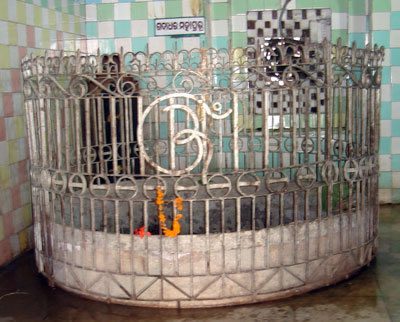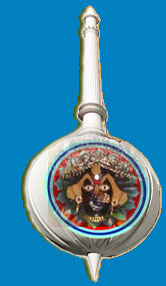


It is believed that there was a temple for Goddess built during the Gupta rule with a rekha vimāna and flat roofed Jagamohan at Jajpur. During the rule of the Somavamsis Candihar Yayati-II had constructed a magnificent temple; the said temple had been destroyed during the Afghan conquest in the year 1568 AD. In the first half of the 19th century a zamindar of Jajpur named Sudarśan Mohāpātra had reconstructed and repaired the temple that we found at present.
The height of the temple is 70ft with the original padmapīṭha (lotus pedaled pīṭha) and a pīdha Jagamohan on the original flat-roofed Jagamohan the candīmaṇḍapa has been constructed in front of the Jagamohan for the purpose of worship and recital of Devi-mahātmya (śaptaśati candī) the temple walls bear fragmentary sculptures of different periods of history i.e. from the 4th century AD to the 15th century AD. There are several temples inside the complex namely Nābhigayā, Jūpesvara, Īśānesvara, Mṛtyunjayesvara, Bhuṣaṇḍesvara, Vagalāmukhī etc. and a large number of sivalingams preserved and worshipped in separate shrines also. The compound wall had been built by a saint Bhikari Das just before one hundred and ten years back. The compound wall bears a good number of Bhaumakara sculptures and images belonging to 8th -10th century AD. The lion-gate of the compound wall is very beautiful and magnificent.
Temple Time Table
5.30 AM TO 1.00 PM
Morning
3.00 PM TO 10.00 PM
Evening
Inscriptions in the Biraja Temple
On account of recurrent invasion and devastation by the iconoclast’s ancient Biraja or modern jajpur was completely destroyed. Hence few inscriptions are met with here and there out of the heap of ruins. However five surviving inscriptions were found in the temple complex of Goddess Biraja.

An inscription is set to the temple belonging to the time of the Ganga emperor Choḍagangadev (12th century AD) the inscription speaks of the offering of lamps to the Goddess Biraja during his visit to the Biraja temple.

The second inscription is set to the upper lintel of the lion’s Gate of the temple, it belongs to the 19th century AD and the script is Odia. A monk named Bhikari Das had constructed the compound wall of the temple collecting funds from the generous public long after the present temple was reconstructed. He had installed the inscription describing the event with date and year.

The third inscription is found inscribed under the pedestal of a “Herostone” kept in front of the Jagamohan. The inscription has not yet been deciphered.
A fragmentary small inscription is found set to the compound wall to the left of the lion’s gate which has not yet been deciphered. Above two inscriptions belong to the8th -9th century AD.
Iconography of Goddess Biraja
The iconography of Goddess Biraja is very interesting and unique. She is a two armed Mahiṣāmardinī image, the parallel of which is found nowhere in India.The Goddess holds a trident in right hand and lifts the tail of the theriomorphic form of the buffalo demon with her left hand so that the front portion of the body is knelt down. Standing in a pratyaliḍha pose she tramples the body of the demon with her left foot and pierces the demon with the trident. The mount lion is absent in the image. The image belongs to the Gupta or pre-gupta period. The crown of the Goddess Biraja is one of the most interesting features in its iconographic characteristics. In her head dress there are the carvings of Gaṇapati (the elephant headed God), yoni (pudendum mulibre), linga (the phallic emblem of siva), Indu (The crescent moon) and phaṇi (the serpent) each having its meaningful implication. The very concept of Gaṇapati is the symbol of synthesis between the Āryān and nonāryān culture. It is said to be the supreme lord, custodian and dispenser of knowledge and wealth social inspiration and a devotional object of the masses, liked and worshipped by all. This indicates her divine importance among the Āryāns and the primitive people. The association of lingam and yoni (the male and female sex organs) symbolizes procreation and productivity.
The mother Goddess is regarded as the creator of all animate and inanimate beings, vegetations and the whole universe. The female sex organ symbolizes the power and receptacle of producing all the above and the male sex-organ is the cause of all procreation and growth. The fundamental belief of genesis of the early man has been depicted through a strange symbolism of human organic instrument. The presence of Indu or crescent moon symbolizes, energy, the nectar of life and remover of all sorts of physical and mental ailments. Lastly the representation of Serpent brings out the omnipotent character of a mother who puts up with all sorts of odds and balances the good and evil. It also symbolizes synthesis of the non-Āryān Naga worshippers and later Vedic Āryāns, Buddhists, Jainas etc. who equally regard snake as an object of divinity. As a whole Goddess Biraja in the form of two-armed Mahiṣāmardinī is depicted as the earliest manifestation of energy incarnate, the creator, dispenser and the destroyer. The Dhyāna Mantras specified in the following chapters corroborate to the carving of the Goddess Biraja.
Navigaya

There is a fathomless well in the close proximity of Goddess Biraja inside the compound which is known as Nabhikupa or Nābhigayā where piṇḍas are offered to the ancestors. As it is a famous Pitṛ-Tīrtha, Hindu religious people from all over India and abroad come over here for the purpose of offering piṇḍas (oblations) to their ancestors in the course of their pilgrimage.
There are two episodes to illustrate the glory and glamour of Biraja Kṣetra or modern Jajpur that have been depicted beautifully in puranic texts. The episode in the Gayā Mahātmya section of the Vayu purāṇa relates a story thus-In the Svetavarāha kalpa a very powerful demon Gayā, who was sincerely devoted to Lord Viṣṇu, performed severe penance on the Kolāhala Mountain for thousands of years in order to achieve utmost purity of body and mind. Gods became scared at his penance and approached Lord Viṣṇu who accompanied them to the demon Gayā in order to grant his desire. The demon on the fulfillment of his desire, attained purity and whosoever touched his body went to Viṣṇuloka (the abode of Lord Viṣṇu) with a liberated soul. The Yamaloka (the abode of the God of death) was desolated Yama, the God of death, in the company of Indra (the God of rain) with other Gods approached Brahma (the creator) who sought the counsel of Viṣṇu. At the advice of Viṣṇu, Brahma entreated Gayā for giving away his pure body for the purpose of a sacrifice, Gayā readily agreed to the proposal and immediately laid down his physical form on the earth in a south-western direction where by his head rested on the Kolāhala Mountain beside the river Falgu his navel on Biraja beside the river Vaitaraṇī and his feet at Pīṭhapuram beside the river Godāvarī, Brahma performed a sacrifice on the Navel of Gayā at Biraja.

As Gayā’s body was unstable and unfavorable for performing the sacrifice, he entreated Viṣṇu and other Gods to help him make the body stable, Viṣṇu wielded his Gadā (club) and made Gayā’s body stable. Gayā complained of his unnecessary torture though he submitted to the desire of the gods. So Viṣṇu asked him to choose a boon for offering his body for a greater interest whereby Gayā chose that Brahma, Viṣṇu and Siva may remain in the three Places where his navel, head and feet fell as long as the earth, mountains, the sun, the moon and, the stars last and let the abodes of these three Gods turn in to Pitṛ-tirthas, The desire of Gayā was granted and Viṣṇu remained at Gayā (kolāhala mountain) where the head of the demon fell. Brahma: adored the Biraja Kṣetra or modern Jajpur where the navel fell and Siva was associated with Pīṭhapuram where the feet rested. Thus the ancient Biraja Kṣetra turned in to a Pitṛ Tīrtha and NaviGayā was evolved out of the navel of demon Gayā, The Biraja Kṣetra mahātmya illustrates the same story with the slightest modification and justified VirajāKṣetra as a Pitṛ-Tīrtha similar to PādaGayā Tīrtha at Pithapuram and Mastaka Gayā Tīrtha beside the riverfalgu in Magadhaor the present Bihar.

The second episode craves for justifying Biraja Kṣetra as a great Śakti pīṭha that was known from the pre-Gupta period. Hence it is a post- facto attempt to put forth the revised version of an earlier tradition of Daksa – Yajna Vidhvamsan- prakaraṇa to sanctify the place. Though the name of Biraja Kṣetra is not found to be associated with any of the limbs of SATI in any of the earlier texts like Kurma purāṇa and Matsya purāṇa etc. Some latter texts of tantra have done so. The story of Daksa – Yajna Vidhvamsana runs thus – SATI, the consort of Siva commits suicide in the sacrificial pit of his father Daksaprajāpati listening to the invectives aimed at her husband Siva.
At this Siva in a fit of rage carries sati’s dead body on the shoulder and starts performing Taṇḍava (a furious dance) dance that indicates the welcome of Pralaya or total destruction of the universe. At the request of the frightened gods, Viṣṇu comes forward in order to save the universe and cuts down sati’s body in to pieces by his wheel weapon.
The limbs of Sati fell at different places of India and gave rise to Śākta pīṭhas, Sati’s navel is said to have fallen in the VirajāKṣetra and so it became known as Nabhipīṭha, a great Śāktapīṭha. However, the tradition goes that the Navel of the demon Gayā and Goddess Sati is the common element and in both the cases Viṣṇu has cut down the body to cause the Navel fall as a result of which the place was glorified either as a Pitṛ-Tīrtha or as a śāktapīṭha. Here again there is an interlinking of the rise of Śakti cult with the Vaishnavite faith in the form of an invisible amalgamation and mysterious process of assimilation between both the religious ideas. There is a novel tradition here that people after offering piṇḍas to their ancestors must have to pray to Goddess Biraja to receive their oblations on behalf of their ancestors instead of praying to lord Viṣṇu as is customary everywhere in India. People from all over India come here to offer piṇḍas to their ancestors at Nābhigayā and a visit to Goddess Biraja throughout the year. The best period for offering such piṇḍas is during the Pitṛ-paksa(Mahālayā) in the month of September i.e. During the dark fortnight of the month of Bhādrapada.
Geography
The abode of Goddess Biraja is situated beside the river Vaitaraṇī flowing through the ancient Biraja kṣetra or modern Jajpur. Jajpur happens to be the headquarters of the district of the same name in Odisha. The place is situated between 200-501-4511N and 860-201-5611E at a distance of 32 kilometers to the east of Jajpur-Keonjhar Road Railway Station on the south Eastern Railway. The nearest aerodrome is Bhubanesvara, the state capital which is at a distance of 120 kilometers connected by National Highway No-5 to the site. It is also situated at a distance of 90 kilometers from Cuttack, the business capital of Odisha. Any one can come over to Jajpur through the Rail-route, Bus, Taxi, or by air at any time of the year.



